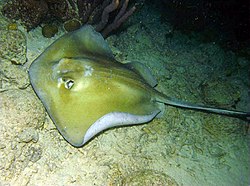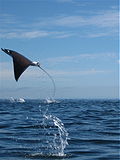Stingray
The stingrays are a large suborder of the rays. They are cartilaginous fish related to sharks. They are in the suborder Myliobatoidei of the order Myliobatiformes, which consists of nine families.[1]
| Stingrays | |
|---|---|

| |
| Southern stingray, Dasyatis americana | |
| Scientific classification | |
| Kingdom: | |
| Phylum: | |
| Class: | |
| Subclass: | |
| Order: | |
| Suborder: | Myliobatoidei
|
Most stingrays have one or more barbed stings on the tail, which is used only for self-defence. The sting may reach about 35 cm, and its underside has two grooves with venom glands.[2] The sting is covered with a thin layer of skin, the sheath, in which the venom is held.[3] A few members of the suborder, such as the manta rays and the porcupine ray, do not have stings.[4]
Stingrays are common in coastal tropical and subtropical marine waters throughout the world. There are species in warm temperate oceans, and some found in the ocean. Some live in fresh water. Most stingrays live at or near the bottom of the water, but some are pelagic.[5]
Lifestyle
Stingrays settle on the bottom while feeding, often leaving only their eyes and tail visible. Coral reefs are favorite feeding grounds and are usually shared with sharks during high tide.[6]
The flattened bodies of stingrays allow them to hide themselves. Stingrays agitate the sand and hide beneath it. Their eyes are on top of their bodies and their mouths on the undersides. Stingrays use smell and electro-receptors (like those of sharks) to find their prey.[7]
Stingrays feed mostly on molluscs, crustaceans, and occasionally on small fish. Some stingrays' mouths have two powerful, shell-crushing plates, while other species have sucking mouthparts that bring in the plankton.
Reproduction
Stingrays are ovoviviparous, bearing live young in 'litters' of five to thirteen. The female holds the embryos in the womb without a placenta. Instead, the embryos absorb nutrients from a yolk sac, and after the sac is depleted, the mother provides uterine 'milk'.[8]
At the Sea Life London Aquarium two female stingrays have delivered seven baby stingrays, although the mothers have not been near a male for two years. "Rays have been known to store sperm and not give birth until they decide the timing is right".
Like all fish, stingrays get little parasites (such as flukes or copepods) on their gills or body. A cleaner fish helps the stingrays by eating the parasites it can get at.
Families
There are eight families in the stingray group. They are:
- Hexatrygonidae (sixgill stingray),
- Plesiobatidae (deep water stingray),
- Urolophidae (stingarees),
- Urotrygonidae (round rays),
- Dasyatidae (whiptail stingrays),
- Potamotrygonidae (river stingrays),
- Gymnuridae (butterfly rays), and
- Myliobatidae (eagle rays).[9][10]
Stingray Media
Pelagic stingray (Pteroplatytrygon violacea), Cape Palos, region of Murcia, Spain. This species of stingray is found worldwide in tropical and warm-temperate oceans. It typically inhabits the open ocean from the surface down to 100 m (330 ft), unlike other stingrays which inhabit the ocean floor. The pelagic
dorsal (topside) ← → ventral (underside)External anatomy of a male bluntnose stingray (Hypanus say) Skeleton of an atlantic stingray (Hypanus sabinus) Atlantic stingray (Hypanus sabinus) undulation locomotion Bat ray (Myliobatis californica) in a feeding posture
References
| Wikimedia Commons has media related to Lua error in Module:Commons_link at line 62: attempt to index field 'wikibase' (a nil value).. |
| Wikispecies has information on: Myliobatoidei. |
- ↑ Gross, Miriam J. (2006). The Stingray. New York: Powerkids Press. ISBN 9781404231900.
- ↑ Ternay, A. "Dangerous and Venomous Aquarium Fish" (PDF). fishchannel.com. Archived from the original (PDF) on 2014-07-22. Retrieved 2011-09-15.
- ↑ Meyer, P. (1997). "Stingray injuries". Wilderness Environ Med. 8 (1): 24–8. doi:10.1580/1080-6032(1997)008[0024:SI]2.3.CO;2. PMID 11990133. S2CID 260140923.
{{cite journal}}: Check|s2cid=value (help) - ↑ Froese, Rainer, and Daniel Pauly, eds. 2009. "Mylobatoidei" in FishBase. FishBase online
- ↑ Bester, C; Mollett, H.F.; Bourdon, J. "Pelagic stingray". Florida Museum of Natural History, Ichthyology department. Archived from the original on 2016-01-15. Retrieved 2011-09-15.
- ↑ "Stingray City — Altering Stingray Behavior & Physiology?". DivePhotoGuide.
- ↑ "Stingray behavior?". ScubaBoard.
- ↑ "Dasyatis sabina". Florida Museum. 9 May 2017.
- ↑ Nelson J.S. 2006. Fishes of the World. 4th ed, Wiley.
- ↑ Helfman, G.S; Collette, B.B.; Facey, D.E. (1997). The diversity of fishes. Blackwell Science. pp. 180. ISBN 9780865422568.









